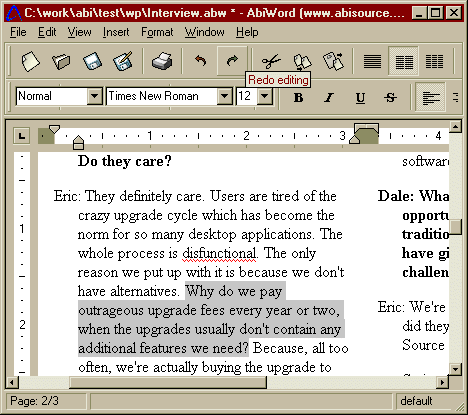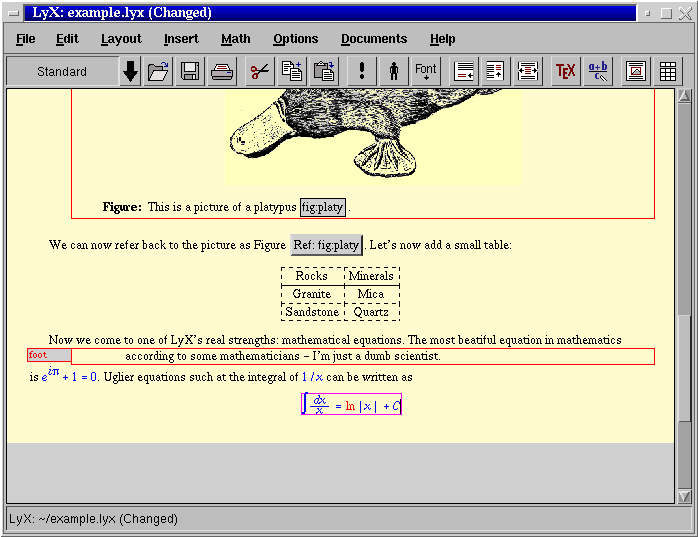14. How to generate something worth printing.
Here we get into a real rat's-nest of software. Basically, Linux can run many types of binaries with varying degrees of success: Linux/x86, Linux/Alpha, Linux/Sparc, Linux/foo, iBCS, Win16/Win32s (with dosemu and, someday, with Wine), Mac/68k (with Executor), and Java. I'll just discuss native Linux and common Unix software.
14.1. Markup languages
Most markup languages are more suitable for large or repetitive projects, where you want the computer to control the layout of the text to make things uniform.
- nroff
This was one of the first Unix markup languages. Man pages are the most common examples of things formatted in *roff macros; many people swear by them, but nroff has, to me at least, a more arcane syntax than needed (see Figure 9), and probably makes a poor choice for new works. It is worth knowing, though, that you can typeset a man page directly into postscript with groff. Most man commands will do this for you with man -t foo | lpr.
Figure 9. Example of roff Input
.B man is the system's manual pager. Each .I page argument given to .B man is normally the name of a program, utility or function. The .I manual page associated with each of these arguments is then found and displayed. A .IR section , if provided, will direct .B man to look only in that .I section of the manual.
- TeX
TeX, and the macro package LaTeX, are one of the most widely used markup languages on Unix. Technical works are frequently written in LaTeX because it greatly simplifies the layout issues and is still one of the few text processing systems to support mathematics both completely and well. TeX's output format is dvi, and is converted to PostScript or Hewlett Packard's PCL with dvips or dvilj. If you wish to install TeX or LaTeX, install the whole teTeX group of packages; it contains everything. Recent TeX installations include pdfTeX and pdfLaTeX, which produce Adobe PDF files directly. Commands are available do create hyperlinks and navigation features in the PDF file.
Figure 10. Example of LaTeX Input
\subsubsection{NAT} Each real server is assigned a different IP address, and the NA implements address translation for all inbound and outbound packets. \begin{description} \item[Advantage] Implementation simplicity, especially if we already implement other NAT capabilities. \item[Disadvantage] Return traffic from the server goes through address translation, which may incur a speed penalty. This probably isn't too bad if we design for it from the beginning. \item[Disadvantage] NAT breaks the end-to-end semantics of normal internet traffic. Protocols like ftp, H.323, etc would require special support involving snooping and in-stream rewriting, or complete protocol proxying; neither is likely to be practical. \end{description}- SGML
There is at least one free SGML parser available for Unix and Linux; it forms the basis of Linuxdoc-SGML's homegrown document system. It can support other DTD's, as well, most notably DocBook. This document is written in DocBook-DTD SGML; see Figure 11 for an example.
Figure 11. Example of DocBook SGML
<VarListEntry> <Term>SGML</Term> <ListItem> <Para> There is at least one free SGML parser available for Unix and Linux; it forms the basis of Linuxdoc-SGML's homegrown document system. It can support other DTD's, as well, most notably DocBook. This document is written in DocBook-DTD SGML. </Para> </ListItem> </VarListEntry>
14.2. WYSIWYG Word Processors
There is no shortage of WYSIWYG word processing software. Several complete office suites are available, including one that's free for personal use (StarOffice).
- StarOffice
Sun Microsystems is distributing StarOffice on the net free for Linux. This full-blown office suite has all the features you'd expect, including both import and export of Microsoft Office file formats (including Word documents). There's a mini-HOWTO out there which describes how to obtain and install it. It generates PostScript, so should work with most any printer that works otherwise on Linux.
- WordPerfect
Corel distributes a basic version of WordPerfect 8 free for Linux, and sells various packages of Word Perfect Office 2000 (which includes WordPerfect, Corel Draw and Quattro Pro Versions 9). The Linux WordPerfect Fonts and Printers page has information about configuring WordPerfect for use with either Ghostscript or its built-in printer drivers (which are apparently identical the DOS WordPerfect drivers, if your printer's driver isn't included in the distribution).
- Applix
Applix is a cross-platform (ie, various Unices, Windows, and others) office suite sold by the Applix company. Red Hat and SuSE sold it themselves when it was the only game in town; now sales have reverted to Applix. This is the only native Unix-style application suite; it probably fits in better with the Unix way of doign things.
- AbiWord
AbiWord is one of several GPL WYSIWYG word processor projects; this one has produced a very nice word processor based on an XML format. It is capable of Word file import. AbiWord is still a work in progress, although it is useful for small things now.
Figure 12. AbiWord

- LyX
LyX is a front-end to LaTeX which looks very promising. See the LyX Homepage for more information. There is a KDE-styled version of LyX, called Klyx; the author of LyX and the instigator of KDE are the same person.
Figure 13. LyX

- Maxwell
Maxwell is a simple MS RTF-format based word processor which started as a commercial product but is now distributed under the GPL.
Other vendors should feel free to drop me a line with your offerings.


